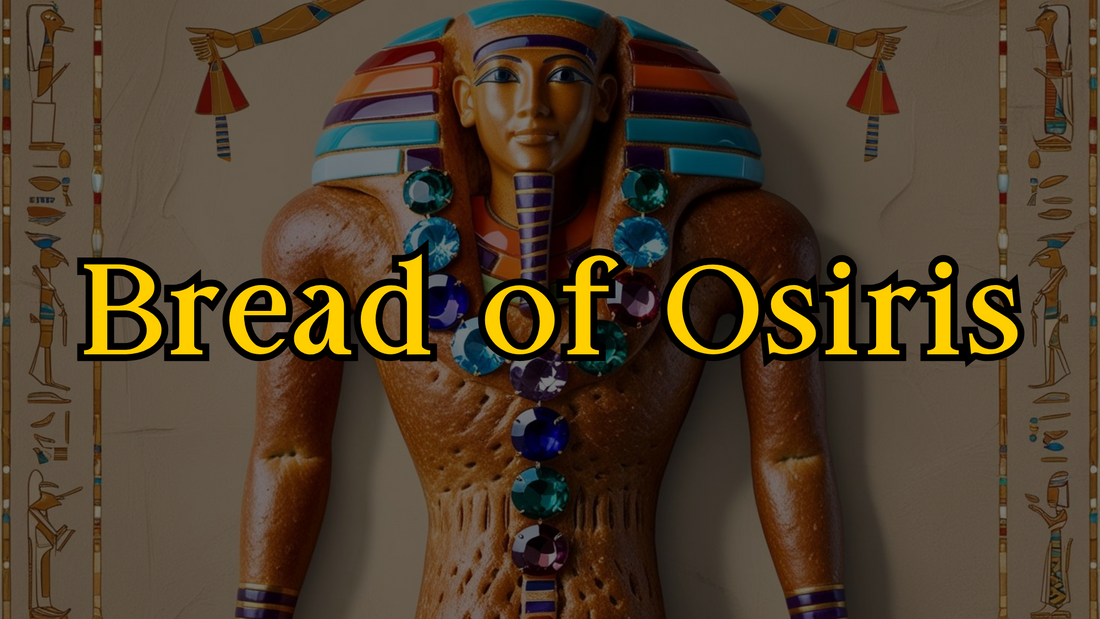
The Mystical Bread of Osiris: Ancient Rituals and the Gems of Resurrection
In the world of ancient Egypt, a land rich with myths, symbols, and rituals, the god Osiris held a central role. Known as the deity of the afterlife, fertility, and resurrection, Osiris’s story is one of death, dismemberment, and miraculous rebirth—a tale that inspired some of the most fascinating ceremonies of the ancient world.
One such ritual involved the creation of special bread shaped like Osiris himself and adorned with precious gemstones. This ancient practice is a treasure trove of mystery and meaning, offering a unique glimpse into the culture and beliefs of ancient Egypt.
 The Myth Behind the Ritual
The Myth Behind the Ritual
The story of Osiris begins with betrayal. According to Egyptian mythology, Osiris was a wise and beloved ruler whose jealous brother, Set, conspired to kill him. After trapping Osiris in a coffin, Set dismembered his body and scattered the pieces across Egypt. Osiris’s devoted wife, Isis, embarked on a quest to find and reassemble his body, and through her magic, brought him back to life. This act of love and resurrection made Osiris a powerful symbol of renewal and eternal life.
The ritual of creating Osiris-shaped bread emerged from this myth. Known as "Divine Bread," these sacred loaves were not only crafted to honour the god but also to symbolically partake in his resurrection. Participants in the ritual sought to connect with Osiris’s promise of immortality and divine protection.
 The Creation of Divine Bread
The Creation of Divine Bread
Crafting the Osiris-shaped bread was a meticulous process, rich in symbolic meaning. Artisans used a mixture of grain and a special paste composed of elements believed to hold spiritual significance. This paste included Nile silt (sorry, but 🤢), dates, aromatic substances like frankincense and fresh myrrh, and a blend of spices revered for their mystical properties. Notably, the bread was embellished with various precious gemstones, each selected for its unique symbolism and association with Osiris.
(I sincerely hope they removed these gemstones before eating the bread though as that really wouldn't have been good for their digestive systems!)
 Gemstones Used and Their Symbolism
Gemstones Used and Their Symbolism
Ancient Egyptian records and artifacts indicate that these ceremonial loaves were adorned with an array of gemstones, each chosen for its distinct attributes:
Carnelian
This vibrant red stone was believed to embody vitality and protection, resonating with Osiris's role as a life-giving deity.
Lapis Lazuli
Esteemed for its deep blue color, lapis lazuli was linked to the heavens and divine wisdom, offering protection in the afterlife.
Turquoise
Associated with prosperity and safeguarding, turquoise was thought to repel negative energies and attract good fortune.
Green Feldspar
Symbolizing growth and fertility, this stone aligned with Osiris's connection to vegetation and the natural cycles.
Amethyst
Valued for its protective qualities and calming energy, amethyst reflected the tranquility and stability Osiris provided in the afterlife.
Red Quartz
Although its specific significance is not well-documented, red quartz may have been associated with strength and the life force due to its bold hue.
Red Jasper
Similar to red quartz, red jasper was likely linked to vitality and protection, given its earthy red tones.
Calcite
While its exact symbolism remains uncertain, calcite's luminous quality might have represented clarity, purity, or the divine light of resurrection.
In addition to these gemstones, other precious materials such as gold and silver were incorporated into the bread, enhancing its spiritual significance.
 Why Gemstones?
Why Gemstones?
Gemstones played a vital role in ancient Egyptian culture, not only for their beauty but also for their symbolic and magical properties. Each stone was believed to carry specific energies that could protect, heal, or enhance the wearer’s connection to the divine. In the context of the Osiris ritual, the gemstones likely represented the god’s scattered body parts and his eventual restoration, signifying the triumph of life over death.
 The Ritual’s Legacy
The Ritual’s Legacy
The practice of creating and consuming Osiris-shaped bread endured for centuries, forming a core part of the Mysteries of Osiris, an annual festival that celebrated the god’s resurrection. Participants in the ritual believed that by consuming the bread, they were imbibing the essence of Osiris, thus securing a connection to his divine power and the promise of eternal life.
While the exact timeline of when this tradition ceased is unclear, the rise of Christianity in Egypt during the first few hundred years AD likely contributed to its decline. Many ancient rituals were gradually replaced by new religious practices, though echoes of these traditions can still be found in symbolic rites like the Christian Eucharist.
 A Gem-Encrusted Mystery
A Gem-Encrusted Mystery
The story of Osiris and the rituals dedicated to him continue to fascinate and inspire. The use of gemstones in these practices reflects a deep connection between the natural world and the divine, a belief that beauty and meaning could be found in every facet of life—and even death.
For modern jewellers and gem enthusiasts, as well as (hopefully) just being a fascinated look into the past, the tail of this ancient ritual serves as a reminder of the profound significance gems have held throughout history. Whether for their aesthetic appeal or their deeper symbolism, gemstones have long been intertwined with humanity’s spiritual journey.
So the next time you hold a carnelian or lapis lazuli in your hand, think of the Osiris bread and the ancient hands that adorned it. Who knows? Perhaps the spirit of Osiris still lingers, bringing a touch of magic to every gem it graces.
